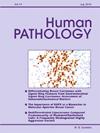Role of genomic analysis in the classification of well differentiated hepatocellular lesions
IF 2.7
2区 医学
Q2 PATHOLOGY
引用次数: 0
Abstract
Background
The distinction of focal nodular hyperplasia (FNH) and hepatocellular adenoma (HCA) from well-differentiated hepatocellular carcinoma (WD-HCC) in noncirrhotic liver can be challenging. High-grade dysplastic nodule (HGDN) in cirrhosis can have overlapping features with WD-HCC. In some cases, HCA diagnosis is evident but glutamine synthetase (GS) staining is indeterminate for β-catenin activation, which does not allow reliable risk assessment. This study examines the role of genomic analysis in better categorization of WD hepatocellular lesions (WDHL).
Design
Genomic analysis using capture-based NGS assay was done in 23 WDHLs that could not be definitely classified based on morphology, reticulin stain and IHC, and were designated as ‘atypical hepatocellular neoplasms’ (AHNs). GS staining was classified as diffuse homogeneous (moderate to strong staining in >90 % of tumor cells), diffuse heterogeneous (50–90 %), not diffuse (<50 %) and borderline (not clear if more or less than 50 %).
Results
The genomic profile provided additional information for the diagnosis and/or risk assessment enabling a benign diagnosis in 15/23 cases (66 %) and HCC in 4/23 cases (17 %), while the diagnosis remained as atypical in the remaining 4 cases. Of the 4 cases with final HCC diagnosis, findings were suspicious but not diagnostic based on morphology/IHC; additional changes like TERT promoter mutation (n = 2), AXIN mutation (n = 1), CDKN2A loss (n = 2) and copy number alterations (n = 3) helped to support HCC. Of the 15 cases with a final benign diagnosis, the status of β-catenin activation was unclear based on GS stain in 8 cases, 2 of which showed CTNNB1 exon 7 mutation, 1 showed CTNNB1 exon 8 mutation, while genomic changes in 5 cases did not show any evidence of Wnt activation. FNH-like features were seen in 2 cases, but the genomic changes excluded FNH (CTNNB1 and ARID1A mutation). The final diagnosis was unchanged from the initial diagnosis of AHN in 4/23 cases (17 %) as the molecular findings did not favor HCC.
Conclusion
Genomic changes were helpful in characterization of WDHLs, supporting HCC in 17 % of cases and clarifying β-catenin activation status in all 7 cases with borderline GS staining. Genomic changes are not specific but can provide diagnostic clues in selected challenging cases that cannot be classified on morphology and IHC. Given the significant treatment implications of distinguishing between HCC and benign/premalignant entities, routine use of genomic analysis in diagnostically challenging settings should be considered.
基因组分析在高分化肝细胞病变分类中的作用。
背景:在非肝硬化肝脏中,局灶性结节性增生(FNH)和肝细胞腺瘤(HCA)与高分化肝细胞癌(WD-HCC)的区别是具有挑战性的。肝硬化高级别发育不良结节(HGDN)可与WD-HCC有重叠特征。在某些情况下,HCA诊断是明显的,但谷氨酰胺合成酶(GS)染色不确定β-连环蛋白激活,这不能进行可靠的风险评估。本研究探讨了基因组分析在WD肝细胞病变(WDHL)更好分类中的作用。设计:使用基于捕获的NGS法对23例wdhl进行基因组分析,这些wdhl无法根据形态学、网状蛋白染色和免疫组化进行明确分类,并被指定为“非典型肝细胞肿瘤”(AHNs)。GS染色分为弥漫性均质(90%的肿瘤细胞中有中度至强染色)、弥漫性异质性(50-90%)和非弥漫性(结果:基因组图谱为诊断和/或风险评估提供了额外的信息,15/23例(66%)诊断为良性,4/23例(17%)诊断为HCC,其余4例诊断为非典型。在最终诊断为HCC的4例中,发现可疑,但不能根据形态学/免疫组化进行诊断;TERT启动子突变(n=2)、AXIN突变(n=1)、CDKN2A缺失(n=2)和拷贝数改变(n=3)等其他变化有助于支持HCC。在最终良性诊断的15例患者中,8例患者的GS染色不清楚β-catenin激活状态,其中2例显示CTNNB1外显子7突变,1例显示CTNNB1外显子8突变,5例患者的基因组变化未显示任何Wnt激活的证据。2例出现FNH样特征,但基因组变化排除了FNH (CTNNB1和ARID1A突变)。4/23例(17%)的最终诊断与最初诊断的AHN没有变化,因为分子检查结果不支持HCC。结论:基因组变化有助于表征wdhl, 17%的病例支持HCC,所有7例边缘性GS染色明确β-catenin激活状态。基因组变化不是特异性的,但可以在不能按形态学和免疫组化分类的选定挑战性病例中提供诊断线索。鉴于区分HCC和良性/癌前实体的重要治疗意义,应考虑在诊断困难的情况下常规使用基因组分析。
本文章由计算机程序翻译,如有差异,请以英文原文为准。
求助全文
约1分钟内获得全文
求助全文
来源期刊

Human pathology
医学-病理学
CiteScore
5.30
自引率
6.10%
发文量
206
审稿时长
21 days
期刊介绍:
Human Pathology is designed to bring information of clinicopathologic significance to human disease to the laboratory and clinical physician. It presents information drawn from morphologic and clinical laboratory studies with direct relevance to the understanding of human diseases. Papers published concern morphologic and clinicopathologic observations, reviews of diseases, analyses of problems in pathology, significant collections of case material and advances in concepts or techniques of value in the analysis and diagnosis of disease. Theoretical and experimental pathology and molecular biology pertinent to human disease are included. This critical journal is well illustrated with exceptional reproductions of photomicrographs and microscopic anatomy.
 求助内容:
求助内容: 应助结果提醒方式:
应助结果提醒方式:


